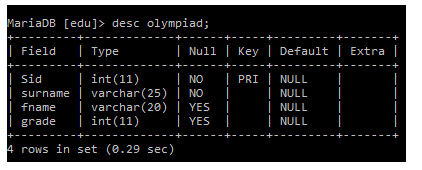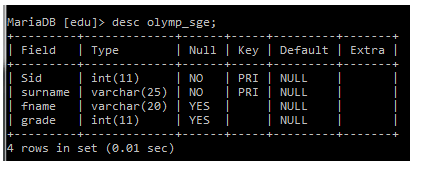Updated March 16, 2023

Introduction to SQL Primary Key
The following article provides an outline for SQL Primary Key. A unique column or group of fields is the primary key. There can only be one primary key per table. Each entry in the table is uniquely defined by its primary key, which is a value or a combination of a few values from the table. Knowing this value or combination makes it simple to locate the relevant record and retrieve all of its remaining values.
Key Takeaways
- Benefits of a primary key include: Each table row is identified by it uniquely.
- It receives a distinct index for each main key column, which facilitates quick access.
- To distinguish between the various items in a table, the main key primary key is required.
What is SQL Primary Key?
Each row or record in a database table is uniquely identified by a field called a primary key. Unique values must be present in primary keys. There can’t be Empty values in a main key column. Null values or duplicate values are not permitted in the primary key column. If we try to do that, an exception will be raised.
Why Use SQL Primary Key?
A particular field or set of fields or columns that may exclusively identify a row in a table is known as the primary key in SQL. To put it simply, it is a column that allows unique values for every row. Therefore, the entry for the primary key column or columns must be unique every time we use the Put INTO command to add new entries to a table.
How to Create SQL Server Primary Key?
The SQL Server Management Studio can be used to define a primary key in SQL Server. A primary key in SQL Server (Transact-SQL) is a column or group of values that specifically identifies an item. An ALTER TABLE statement or a CREATE TABLE statement can both define a primary key.
The constraint ensures individuality and makes sure that no field that is a portion of the Primary Key can have a NULL value. In SQL Server, the Primary Key constraint is a column (or a set of columns) that uniquely defines each row in the table.
Code:
CREATE TABLE tb_name
(
col1 datatype [ NULL | NOT NULL ],
col2 datatype [ NULL | NOT NULL ],
...
CONSTRAINT constt_name PRIMARY KEY (col1, col2, ... col_n)
);SQL Primary Key Constraint
A primary key is a kind of constraint that stops us from entering null or duplicate entries. This restriction is necessary to identify the records uniquely under the circumstances. The below example shows how constraint is applied to a Primary key while creating a table.
To add a constraint we can use:
Code:
ALTER TABLE Olympiad ADD CONSTRAINT olymp_new PRIMARY KEY (Sid, Sname);Examples of SQL Primary Key
Consider a table called Olympiad with columns for the Olympiad registration sid,fname, surname, and grade class. These are the form for a given class. Now that each student in a class who is registering like this will have a distinct Sid, we can make that column our primary key.
Let’s make a table of Olympiad registration with the primary key being their sid.
SQL Primary Key using Create table.
Code:
create table olympiad (Sid int NOT NULL, surname varchar(25) NOT
NULL, fname varchar (20), grade int, PRIMARY KEY (Sid));When the “Olympiad” table is created, the following SQL statement establishes a PRIMARY KEY on the “Sid” column.
Output:
The above example is for a single-column primary key. To do this, we include the column name in the PRIMARY KEY() brackets. This shows that the column Sid is our primary key, and it must meet all requirements to be a primary key to uniquely identify the data.
Primary Key on two fields
Code:
create table olymp_sge (Sid int NOT NULL, surname varchar(25) NOT NULL, fname varchar (20), grade int,CONSTRAINT olump_new PRIMARY KEY (Sid,surname));Output:
The sid and surname columns together will make up the primary key, and the new primary key made up of two columns is called olump_new. The name of the main key constraint, which is effectively the combination of the two columns, is olump_new. Such name is needed to identify the table’s primary key, which is then used to differentiate distinct records. As a result, in this context, whenever we refer to olump_new, we are referring to the primary fields created by the combination of the sid and surname columns.
Primary Key using Alter
To change the field in the existing table to Primary Key we need to give ALTER statement.
Code:
alter table olymp_sge ADD PRIMARY KEY(Sid);The below output shows when we try to alter a field it shows an error stating ‘ Multiple Key is defined as we have declared the primary keys already.
Output:
FAQ
Given below are the FAQs mentioned:
Q1. What is the need for a Primary key in a Table?
Answer: The dataset’s primary key aids in avoiding redundant or duplicate values. The primary field is essential for linking more than one table together. Since the primary field has distinct values to distinguish every record individually, we use it while merging two or more tables.
Q2. What type of Datatype can be used for a Primary Key?
Answer: The primary field need only include all distinct and non-null values. It can be an integer or character data type.
Q3. Which two properties do any SQL primary keys have?
Answer: Maximum primary column size is 900 bytes. A column with the main key cannot include null values. A basic primary key is one with only one column. Those with numerous columns are referred to as having a composite primary key.
Conclusion
All there is to know about the SQL primary key is covered in this article. We have seen how and where to create it using the CREATE TABLE and ALTER TABLE commands at various levels and in various databases. In this article, we also looked at the process of deleting a primary key across various databases. A key restriction that will enable preserving the integrity and validity of databases is the primary key.
Recommended Articles
This is a guide to SQL Primary Key. Here we discuss the introduction, and how to create an SQL server primary key. key constraint and examples. You may also have a look at the following articles to learn more –



